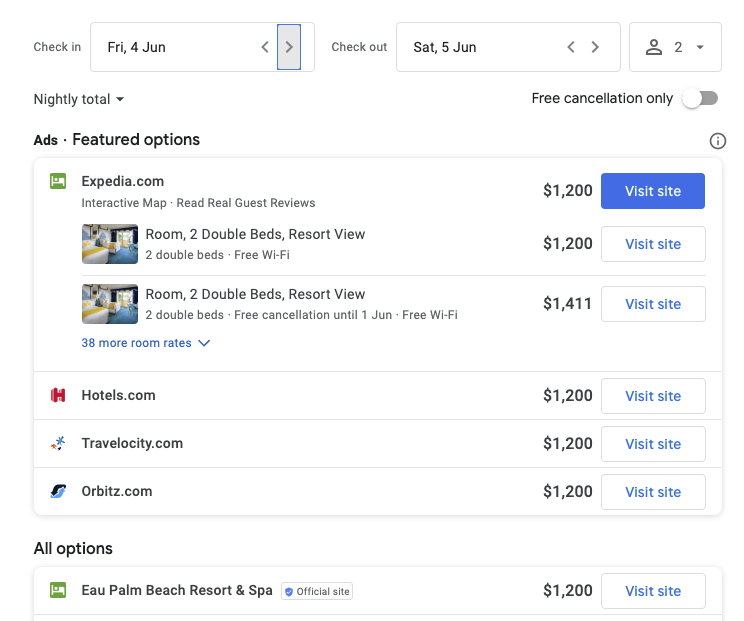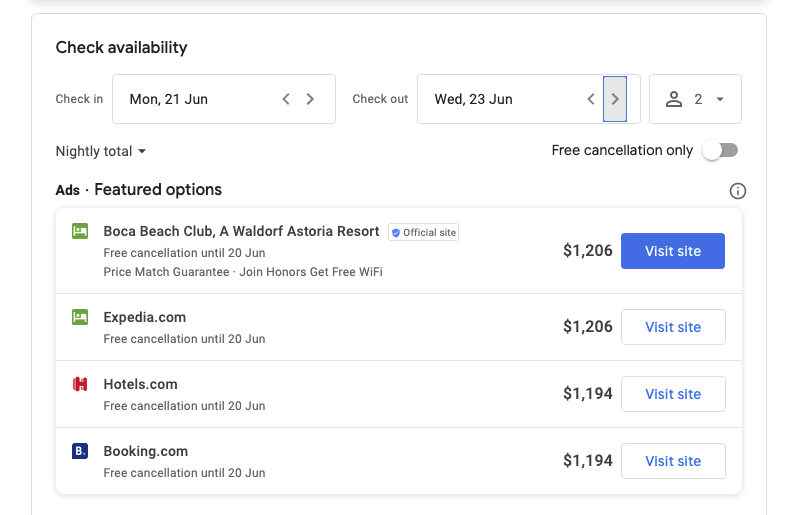The Importance of Rate Parity for Hotel Websites
What Is Rate Parity?
While “rate parity” might sound like a complicated idea, it is something that we are all familiar with. For hotels, it means simply maintaining consistent rates across the distribution channels. Sometimes it is a good strategy for hotel’s NOT to be in rate parity; you have an upcoming period with low reservations, run a flash sale through Online Travel Agencies (OTAs) and hopefully you can get some last-minute bookings through a variety of channels that would be impossible for you to advertise on without their network. However, for most hotels, driving direct reservations through the official website is a priority. If this is the case for your hotel, then you want your efforts focused ensuring that your hotel remains within rate parity and that users are not able to book a different rate elsewhere.
Example of Hotel in Rate Parity

Example of Hotel out of Rate Parity

Why is Rate Parity Important for Hotels?
A study conducted in the U.S. found that 85% of consumers’ listed price as the most important factor for where and when they make a purchase. Close to the importance of price were reliability, choice and convenience. These combined are all factors that help determine a particular purchase decision.
If you think about your own shopping habits, there have probably been times where you have been confronted with a purchase decision. You will see two very similar items, you expect to get the same “value” out of the two and so you end up choosing the one that is lower in price.
Hotels are a bit different. The reliability, choice and convenience certainly play a larger role compared to purchasing a ‘loaf of bread’. However, the end comparison with hotels is usually the same - a night in a hotel room. This is why hotels need to distinguish themselves differently with advantages such as; delivering a quality guest experience, building on a rewards or frequent traveler program for repeat guests and providing incentives to book directly. Even still there are consumers that will choose to book through an OTA or similar channel simply because the price is cheaper.
How can hotels help protect against consumers that are comparing pricing? If your hotel is in rate parity, and potential guests are not able to book a lower rate outside of your hotel, then there are no price incentives to drive them to book through an outside channel.
Why Rate Parity is Important in Digital Marketing?
It is estimated that the average guest at your hotel will visit your website about 5 times prior to booking a room. During that time, they are likely visiting social media sites, reading reviews, researching their vacation, etc. We call the process from research to reservation, the “booking funnel” and a proper digital marketing strategy will target different areas of the funnel to help guide a user to a direct booking on your website. If your hotel is not in rate parity, this could be impacting several different areas of your hotel’s booking funnel and digital marketing strategy.
We have observed GCommerce clients whose annual Organic Traffic rates decline as much as 22% when they are not in rate parity. During that time, the properties saw a marked increase in the percentage of revenue from OTA contributions. Considering that Organic Traffic is “free” (you don’t necessarily pay per-click or for impressions), this is a huge decline in direct revenue for the property and in turn we had to increase digital marketing costs to compensate for the decline in Organic Traffic.
Your hotel’s digital marketing strategy might utilize Display or Facebook Prospecting Ads. This is a great way to get ‘in front’ of new customers and help grow your properties' brand awareness. You could spend efficiently and target the exact audience, however, as those same individuals that interact with a Display or Facebook ad continue their booking journey, it is very likely we will lose some of them to OTAs, especially if they are incentivized by a lower rate.
This is kind of a “double-whammy” where your hotel could be paying money to help bring potential guests into your sales funnel with digital ads, only to also pay a percent commission on those bookings when those users are inevitably enticed to book with a lower rate on an OTA.
When Is It “OK” To Be Out of Rate Parity?
Much like all online businesses, OTAs are in a very competitive field battling for the same consumer dollars that you are. They organize hotel results on their sites based on price and rate parity as they are also trying to provide the best booking experience for their guests.
Understanding the market that you are in (bigger markets = more competition) and understanding your hotel’s needs can help you appear higher in OTA results for specific dates compared to your competitors. With this information along with the need periods from the hotel, being out of rate parity can be an effective strategy to drive short term bookings. However, due to the cost of acquisition on an OTA commission in comparison to the cost of acquisition on a direct booking, this is not an effective long-term strategy that we would recommend to clients, although it can be impactful at times.
Can you Manage Rate Parity?
Distributing rates to the OTAs can sometimes be unknown to clients, but the easiest way some of our clients found to control parity is to not participate in Expedia/Booking member rates and Genius type programs and not to set up promotions on the OTAs that are lower than the corresponding promo running on direct channels.
If you work with wholesalers, you may need to audit contracts and ensure there is a "no forward distribution" clause as this has caused obstacles at hotels, wholesalers will put the rates on public facing travel websites at what should be their negotiated and meant to be opaque discount rate. This can usually be easily spot-checked by using Google to search dates and if they see random companies with very low rates (that stay low when they click through to book), then they know there is an issue somewhere.
How To Build a Balanced Digital Marketing Strategy Around Direct Bookings?
While the OTAs can certainly be a powerful tool to utilize at times, at GCommerce, we recommend a balanced digital marketing strategy that focuses on direct bookings. Incentivizing guests to book directly is more than just having the best, or an equal rate, it is about well-adjusted strategies that help build brand recognition and customer loyalty. Your hotel digital marketing strategies should be focused on the potential audience in your sales funnel, focusing on the long-term sustainable competitive advantages that provide your guests with the value and experience they are looking for during their stay. At times, it may be necessary to provide better rates for OTAs, but most of the time, your hotel should be focused on increasing the digital marketing tactics that help increase the contribution of direct bookings and rate parity is a key aspect of such strategies.
Get Started on Your Hotel Digital Marketing Strategy Today
Contact GCommerce Solutions today to get your hotel on a digital marketing strategy to help drive direct bookings and lessen the contributions to your property from OTAs.


